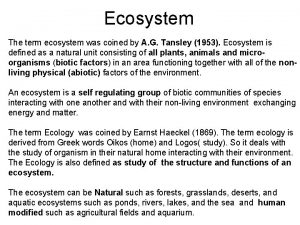Washington Consensus The Washington Consensus a term coined


- Slides: 2

“Washington Consensus” • The “Washington Consensus, ” a term coined by John Williamson, is intended to represent the policy advice offered by the World Bank, IMF, and US government (all located in Washington, DC. ) • The “Washington Consensus” is closely associated with the market-led theory of economic development. • Hence the “Washington Consensus” emphasizes • Private property rights • Market prices (including interest rates) • Economic openness • (free trade and openness to direct foreign investment) • Macroeconomic stability • Critics charge that the “Washington Consensus” ignores the active state role in the most successful late developing countries.

“Beijing Consensus” • The term “Beijing Consensus” was coined by Joshua Ramo to represent an alternative set of policy prescriptions to the “Washington Consensus. ” • “It replaces the widely-discredited Washington Consensus, an economic theory made famous in the 1990 s for its prescriptive, Washington-knows-best approach to telling other nations how to run themselves. The Washington Consensus was a hallmark of end-ofhistory arrogance; it left a trail of destroyed economies and bad feelings around the globe. China’s new development approach is driven by a desire to have equitable, peaceful highquality growth; critically speaking, it turns traditional ideas like privatisation and free trade on their heads (Ramos 2004). ” • The Beijing Consensus is commonly associated with the state-led theory of economic development. • The “Beijing Consensus” emphasizes that there is no one right answer to • Forms of property rights • Reliance on market prices • Degree and timing of economic openness • Critics charge that the “Beijing Consensus” ignores the extent to which the Chinese state has gradually introduced non-state (private and foreign) ownership, market prices, and freer trade albeit combined with an active state role in economic development.



